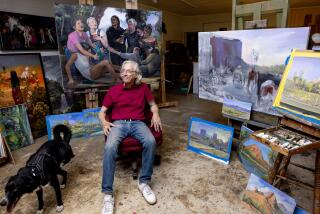Medieval art studio out of time and place?
- Share via
SOUTHFIELD, MICH. — For nearly 12 years, T. Julian Baksik has spent his days designing high-tech fuel alternatives for the auto industry -- and his nights turning discarded copper wire and scrapped chunks of steel into larger-than-life baroque-style sculptures.
When Baksik, 36, moved to an old farmstead in this northwestern suburb of Detroit two years ago, he thought he’d found a perfect home for both his days and his nights.
The 2.4-acre lot was a comfortable commute to Energy Conversion Devices Inc., where he designed batteries for electric cars. And it had more than enough room for his medieval-style art studio -- complete with wooden tools, iron chisels, a small blacksmith’s forge and a bronze-melting foundry about the size of a large office desk.
But city officials have threatened to shut down his studio, citing noise complaints from neighbors. They’ve also said he doesn’t have the appropriate permits to operate such a large studio on his property.
Baksik doesn’t understand why the city is making his life difficult. “Everyone talks about leaving Michigan,” he said. “I thought they’d want to support someone actually staying here.”
The 800-square-foot studio, as large as his two-bedroom house, is tucked in the middle of a thick grove of oak and sycamore trees and situated at the end of a winding dirt road, far off the main street.
He converted the barn-like structure, mounting medieval church window frames along the building’s exterior and lining the lawn with some of his work.
The tools and remote setting have allowed Baksik to create his pieces -- a 12-foot-tall Roman-style fountain featuring the mythological sea god Neptune, for example, or a series of bronze female figures drawn from John Milton’s “Paradise Lost” -- which have been snapped up by collectors around the country.
Southfield officials declined to comment last week, and a spokesman for Mayor Brenda L. Lawrence said Friday that she was looking into the matter.
The dispute began about two months ago, when the city received an anonymous noise complaint from a neighbor, said Gerry Witkowski, code enforcement director for Southfield.
The closest neighbor is nearly half an acre away, but close enough to hear the sounds of Baksik grinding steel beams in the middle of the night, Witkowski said. At the time, Baksik was turning the metal lengths into a limber skeletal frame for a statue of the goddess Minerva.
“We sent an officer out to investigate and found that things were a mess,” Witkowski said, adding that there was stuff lying everywhere and that Baksik did not have the proper permits.
“We told him what to fix and clean up, and he’s done that,” Witkowski said. “We also told the building department about what he was doing.” The building department monitors the permit process.
In March, city inspector David M. Blakeman stopped by Baksik’s property and gave him a written citation to stop work inside the studio. The citation, posted on the outside of the studio’s whitewashed wooden doors, came with a verbal warning: The studio was too large -- and housed too many unusual tools -- for the property’s permit.
Baksik said he did not think to research before he bought the property exactly what permits would be required or whether there were zoning restrictions on what he’d be able to do there.
He said he had done this sort of artwork when he lived in Detroit in the 1990s, which was when he first got the idea to tap the auto industry for raw materials. He was a struggling artist, but he was interested in taking on larger projects.
“Ambitions demand improvising,” Baksik said. “When you try to do a 10-foot sculpture, and the budget you work with is $2,000 rather than $20,000, you learn you have to be creative on how to stretch your finances.”
While living in the more urban areas of Detroit and the nearby suburb of Warren, Baksik also struggled to find a space big enough for his gear. Then he discovered the house on Berg Road.
The house itself is a ramshackle, aging structure with a basement that routinely floods. It has no access to natural gas and relies on a well, rather than city pipes, for water. But the open space drew him to the property, as did a storage facility -- which Baksik converted into the studio -- in the back.
Baksik, a Michigan native, said he thought the city of Southfield (population about 78,000) would embrace the chance to see someone new move in -- particularly since its population and tax base have been on a steady decline over the last seven years due to the downward spiral of the auto industry.
Baksik said he was working with the city to get the proper permits. He needs the studio now more than ever: Last month, he lost his job when his company downsized.
“The inspector called me recently, to check on things,” Baksik said. “He told me that I should tear down the studio and build an extension to my house. I had to laugh, because if I tear it down, I can’t do my art. And if I can’t do art, I can’t pay my mortgage, and I’ll lose everything.”
But Witkowski insists the city doesn’t want to drive the artist away. “We don’t want any of our residents to leave,” Witkowski said. “We just have to figure out a way for a medievalist to live and work in our suburbs.”
More to Read
Sign up for Essential California
The most important California stories and recommendations in your inbox every morning.
You may occasionally receive promotional content from the Los Angeles Times.










